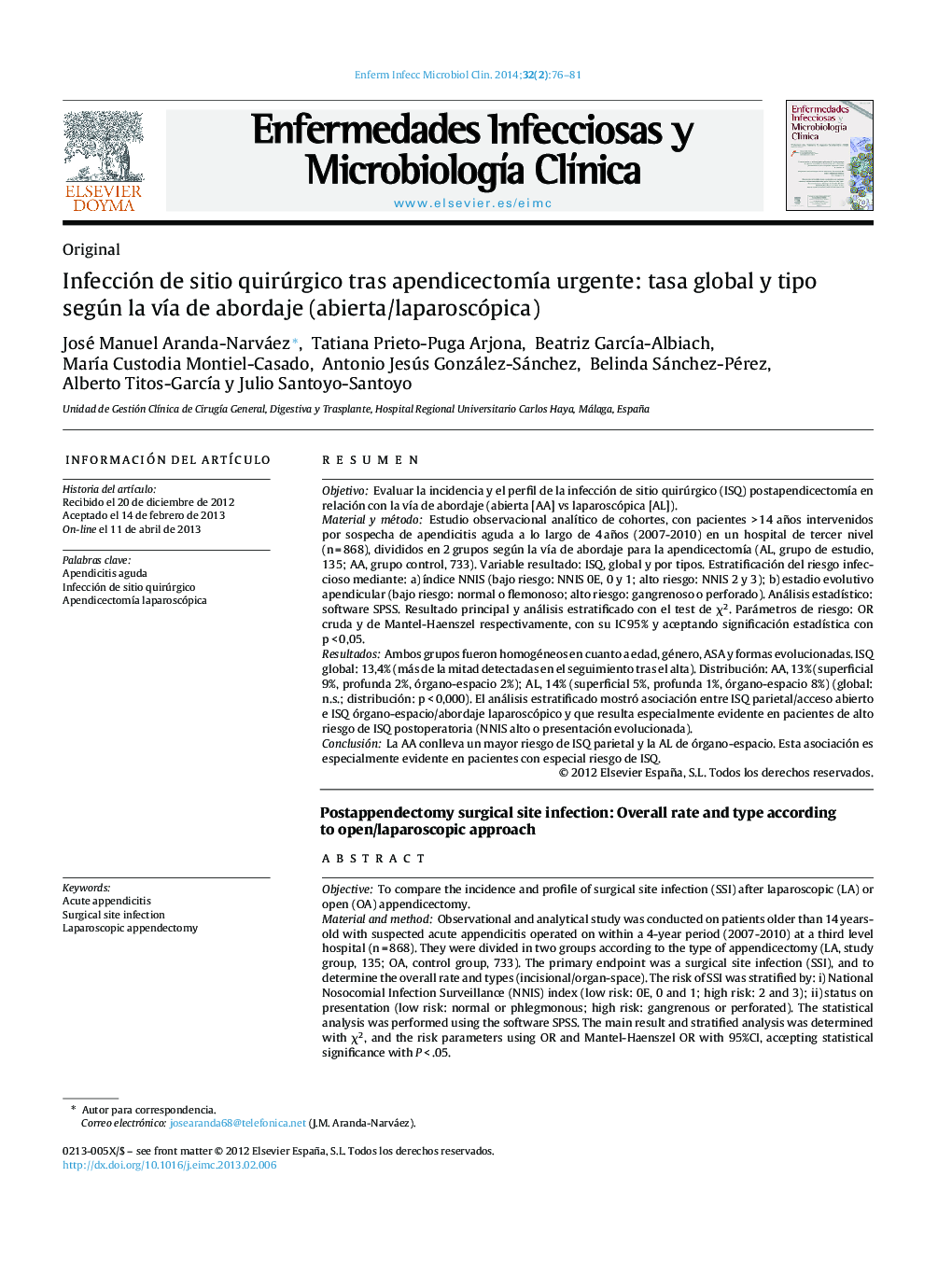| کد مقاله | کد نشریه | سال انتشار | مقاله انگلیسی | نسخه تمام متن |
|---|---|---|---|---|
| 3400992 | 1222642 | 2014 | 6 صفحه PDF | دانلود رایگان |
ResumenObjetivoEvaluar la incidencia y el perfil de la infección de sitio quirúrgico (ISQ) postapendicectomía en relación con la vía de abordaje (abierta [AA] vs laparoscópica [AL]).Material y métodoEstudio observacional analítico de cohortes, con pacientes > 14 años intervenidos por sospecha de apendicitis aguda a lo largo de 4 años (2007-2010) en un hospital de tercer nivel (n = 868), divididos en 2 grupos según la vía de abordaje para la apendicectomía (AL, grupo de estudio, 135; AA, grupo control, 733). Variable resultado: ISQ, global y por tipos. Estratificación del riesgo infeccioso mediante: a) índice NNIS (bajo riesgo: NNIS 0E, 0 y 1; alto riesgo: NNIS 2 y 3); b) estadio evolutivo apendicular (bajo riesgo: normal o flemonoso; alto riesgo: gangrenoso o perforado). Análisis estadístico: software SPSS. Resultado principal y análisis estratificado con el test de χ2. Parámetros de riesgo: OR cruda y de Mantel-Haenszel respectivamente, con su IC 95% y aceptando significación estadística con p < 0,05.ResultadosAmbos grupos fueron homogéneos en cuanto a edad, género, ASA y formas evolucionadas. ISQ global: 13,4% (más de la mitad detectadas en el seguimiento tras el alta). Distribución: AA, 13% (superficial 9%, profunda 2%, órgano-espacio 2%); AL, 14% (superficial 5%, profunda 1%, órgano-espacio 8%) (global: n.s.; distribución: p < 0,000). El análisis estratificado mostró asociación entre ISQ parietal/acceso abierto e ISQ órgano-espacio/abordaje laparoscópico y que resulta especialmente evidente en pacientes de alto riesgo de ISQ postoperatoria (NNIS alto o presentación evolucionada).ConclusiónLa AA conlleva un mayor riesgo de ISQ parietal y la AL de órgano-espacio. Esta asociación es especialmente evidente en pacientes con especial riesgo de ISQ.
ObjectiveTo compare the incidence and profile of surgical site infection (SSI) after laparoscopic (LA) or open (OA) appendicectomy.Material and methodObservational and analytical study was conducted on patients older than 14 years-old with suspected acute appendicitis operated on within a 4-year period (2007-2010) at a third level hospital (n = 868). They were divided in two groups according to the type of appendicectomy (LA, study group, 135; OA, control group, 733). The primary endpoint was a surgical site infection (SSI), and to determine the overall rate and types (incisional/organ-space). The risk of SSI was stratified by: i) National Nosocomial Infection Surveillance (NNIS) index (low risk: 0E, 0 and 1; high risk: 2 and 3); ii) status on presentation (low risk: normal or phlegmonous; high risk: gangrenous or perforated). The statistical analysis was performed using the software SPSS. The main result and stratified analysis was determined with χ2, and the risk parameters using OR and Mantel-Haenszel OR with 95%CI, accepting statistical significance with P < .05.ResultsAge, gender, ASA index and incidence of advanced cases were similar in both groups. The overall SSI rate was 13.4% (more than a half of them detected during follow-up after discharge). Type of SSI: OA, 13% (superficial 9%, deep 2%, organ-space 2%); AL, 14% (superficial 5%, deep 1%, organ-space 8%) (overall: not significant; distribution: P < .000). Stratified analysis showed that there is an association between incisional SSI/OA and organ-space SSI/LA, and is particularly stronger in those patients with high risk of postoperative SSI (high risk NNIS or gangrenous-perforated presentation).ConclusionOA and LA are associated with a higher rate of incisional and organ-space SSI respectively. This is particularly evident in patients with high risk of SSI.
Journal: Enfermedades Infecciosas y Microbiología Clínica - Volume 32, Issue 2, February 2014, Pages 76–81
